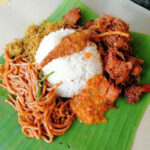Nasi Ambeng: The Rice Platter Popular Among the Javanese Community in Malaysia
Nasi Ambeng (or Nasi Ambang) is a traditional Javanese dish that was introduced to Malaya by Javanese migrants around the late 19th to early 20th century. It has since become an integral part of Malaysian culinary heritage, particularly in the states of Selangor and Johor, where the largest population of Javanese-Malay resides.
Nasi Ambeng consists of a generous portion of white rice served in a round tray or dulang, surrounded by a harmonious medley of flavourful side dishes, bearing resemblance to Nasi Campur (mixed rice). While the side dishes of Nasi Ambeng can vary, some staples include fried tempeh, serunding kelapa (toasted coconut flakes), bergedel (potato fritters), rempeyek (savoury crackers), various types of ulam (raw or blanched vegetables) and Javanese fried sambal. Side dishes like rendang, ayam masak kicap (chicken cooked in soy sauce), fried chicken, salted fish are commonly found too. Some even add fried noodles as an extra condiment. Regardless of the side dishes, Nasi Ambeng promises a satisfying meal bursting with addictive flavours and textures.
Finding Nasi Ambeng in local stalls and restaurants is a rare treat. It is often reserved for special occasions, religious gatherings, anniversaries, and weddings. During these festive events, Nasi Ambeng is served communally, placed on a the round tray to be shared among four to six people. The word ‘Ambeng’ in the name came from the Javanese word ‘ambengan’, which means to gather or sit together.
According to Javanese tradition, the head of the attending family samples a bit of the rice before distributing it evenly among the guests to take home as a blessing for their families. The unique way of serving Nasi Ambeng represents not only its deliciousness but also symbolizes unity, harmony, and happiness within the community.
Nasi Ambeng is also typically served without any sauce or gravy. The dishes are intentionally prepared in a dry format. This is not by chance but rather by design. Since the guests are taking a portion of Nasi Ambeng home to their families, by keeping the components dry, it ensures that the food remains fresh longer and could be enjoyed for more days.
To savour Nasi Ambeng, simply place all the side dishes you’ve prepared onto a plate alongside the rice and indulge! Even though there’s no wrong way to enjoy a plate of Nasi Ambeng, for a complete experience, try eating it with your bare hands instead of utensils; It truly adds to the overall satisfaction.





